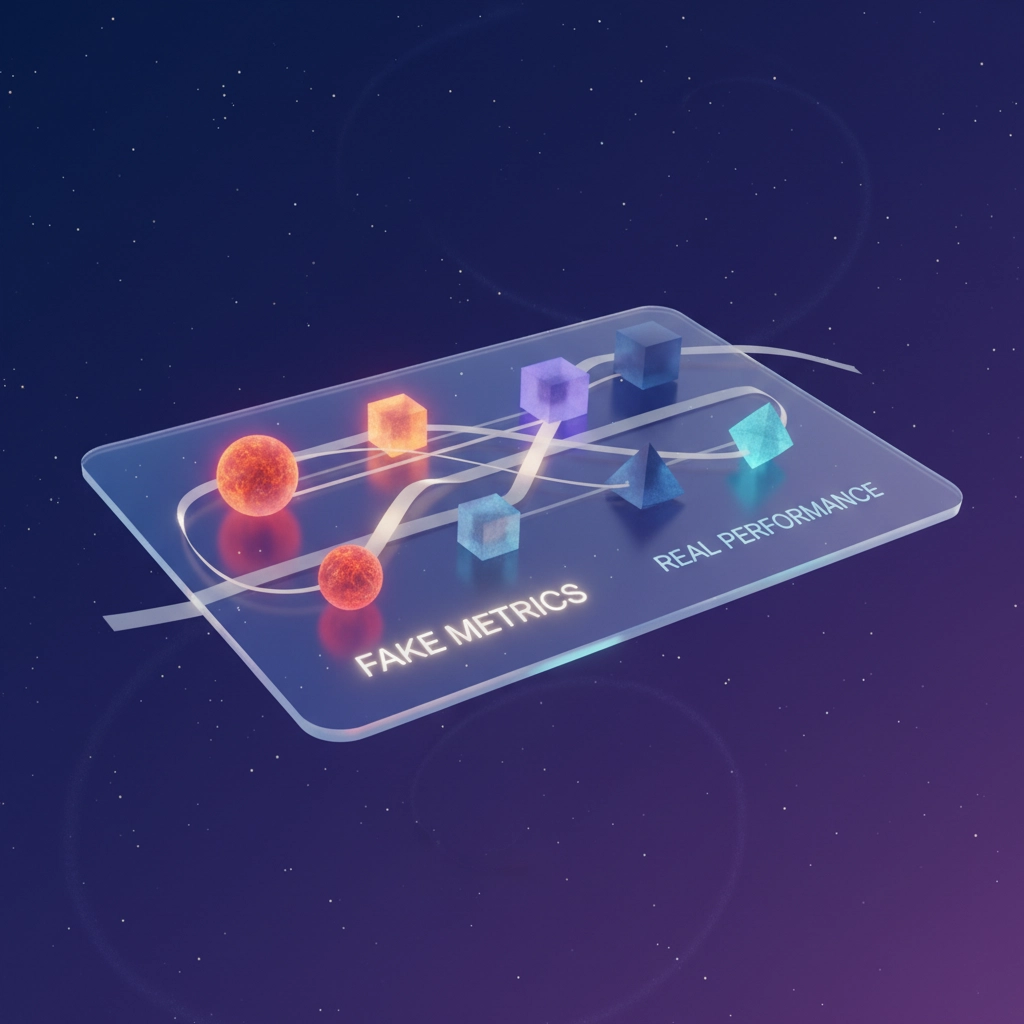How to Spot "Fake" Uplift in Google Ads Performance Reports
- jax5027
- Sep 11
- 5 min read
You've just received your monthly Google Ads report. The numbers look brilliant. CTR is up 127%! Impressions have skyrocketed! Your agency is practically doing cartwheels in their email signature. But here's the uncomfortable truth: that "growth" might be as fake as a three-pound note.
Welcome to the murky world of performance report shenanigans, where a 2% increase can masquerade as earth-shattering growth and bot clicks get counted as genuine customer interest. If you're an eCommerce business owner who's ever wondered whether those impressive-looking metrics actually translate to real revenue, this guide will help you separate the wheat from the digital chaff.
What Exactly Is "Fake" Uplift?
Before we dive into the detective work, let's establish what we're dealing with. Fake uplift in Google Ads reports comes in two delicious flavours:
The Fraudulent Kind: This includes click fraud, bot traffic, and other dodgy activities that inflate your metrics without bringing real customers. Think of it as paying for a crowd of mannequins to attend your shop opening.
The Misleading Kind: This involves creative data presentation that makes poor performance look stellar. It's the marketing equivalent of using flattering angles on your dating profile - technically not lying, but definitely not the whole truth.
Both types will drain your budget faster than a leaky bucket while making you believe everything's going swimmingly.
Red Flags That Should Make You Suspicious
Traffic Patterns That Don't Make Sense
Ever noticed traffic spikes at 3 AM from countries you've never targeted? Unless you're selling insomnia cures to insomniac globe-trotters, this should raise eyebrows. Genuine eCommerce traffic follows predictable patterns - people shop during lunch breaks, evenings, and weekends. If your "customers" are apparently browsing at dawn from data centres in Eastern Europe, you're probably not looking at real shoppers.

Watch out for multiple clicks from the same IP address within minutes. Yes, office buildings share IP addresses, but if you're seeing 50 clicks from the same location in an hour, that's either the world's most indecisive shopper or something fishy is happening.
The Great Analytics Mismatch
Here's where things get properly suspicious. Your Google Ads dashboard shows 1,000 clicks, but Google Analytics only recorded 700 sessions. Where did those 300 clicks disappear to? Did they get lost in the digital Bermuda Triangle?
This discrepancy often indicates click fraud or bot traffic. Real humans who click on ads typically land on your website and trigger analytics tracking. Bots, on the other hand, might click your ad but fail to properly load your site or execute tracking scripts.
Engagement That's Faker Than Reality TV
When your bounce rate suddenly resembles a kangaroo on a trampoline, pay attention. If visitors are arriving and leaving faster than you can say "abandoned cart," you're dealing with either terrible user experience or fake traffic. Bot traffic typically exhibits unnaturally high bounce rates because, surprise surprise, bots aren't interested in your product descriptions or customer reviews.
Similarly, if your average session duration drops to single digits while clicks increase, you're probably paying for traffic that has no intention of buying anything.
The Art of Deceptive Reporting
Percentage Wizardry
Ah, percentages. The magician's best friend in the world of performance marketing. Here's how this trick works: your campaign spent £100 last month and generated £150 in revenue. This month, it spent £103 and generated £153. Technically, that's a 3% increase in spend with a 2% increase in revenue.
But watch as this gets spun: "Campaign performance improved with revenue growth outpacing spend increases!" Technically true, practically meaningless.

Another favourite is the baseline manipulation. "Traffic increased 400% compared to last month!" sounds impressive until you discover last month's baseline was during a week-long site outage.
Cherry-Picked Time Frames
Ever wondered why your reports always seem to show growth, but your bank balance suggests otherwise? Welcome to the wonderful world of strategic time frame selection.
Agencies and platforms love comparing your performance to the quietest week of the year, or to a period when your main competitor was running a massive sale. "Your CTR increased 85% compared to the same period last year!" they'll crow, conveniently forgetting that last year's comparison period was during a global pandemic lockdown.
Metric Substitution
This is where things get properly sneaky. Can't show decent conversion growth? Let's focus on click-through rates instead! Revenue looking wobbly? Time to talk about impression share! It's like judging a restaurant's quality by how many people walk past it rather than how many actually eat there and come back.
How to Actually Verify Your Performance
Cross-Reference Everything
Don't rely on a single source of truth. Compare your Google Ads data with Google Analytics, your eCommerce platform analytics, and your actual sales figures. If Google Ads claims you received 500 conversions but your Shopify dashboard shows 300 orders, something's not adding up.
Set up conversion tracking properly across all platforms. This means implementing Google Analytics Enhanced Ecommerce, connecting your CRM, and ensuring your tracking pixels are firing correctly. Yes, it's a faff, but it's better than paying for imaginary customers.
Monitor Your Fundamentals
Keep a close eye on metrics that actually matter to your bottom line:
Cost per acquisition (CPA): Not just cost per click
Return on ad spend (ROAS): Based on actual revenue, not estimated values
Lifetime value: Are these "new customers" buying again?
Quality of traffic: Are people engaging with your site or bouncing immediately?

If your CPA is creeping up while your conversion quality is declining, you're likely dealing with lower-quality traffic, regardless of what the impression and click metrics suggest.
Implement Fraud Detection
Use tools like ClickCease or PPC Protect to identify and block suspicious traffic automatically. These platforms can spot patterns that human eyes might miss and prevent fraudulent clicks from draining your budget.
Also, regularly audit your search term reports. If you're seeing clicks for completely irrelevant terms (think "free puppies" when you're selling enterprise software), your campaigns might be attracting the wrong kind of attention.
Questions to Ask Your Agency or Platform
Don't just accept reports at face value. Here are some pointed questions that will separate the professionals from the snake oil salespeople:
"Can you show me how these metrics translate to actual revenue in my accounting system?"
"What's the discrepancy between platform-reported conversions and actual sales?"
"Why are we comparing to this specific time period?"
"What steps are you taking to prevent click fraud?"
"Can you break down traffic quality by source and engagement metrics?"
If they start mumbling about "industry benchmarks" or "attribution windows" without providing concrete answers, you might need to dig deeper.
The Bottom Line
Spotting fake uplift in Google Ads reports isn't just about protecting your budget (though that's important). It's about making decisions based on reality rather than digital smoke and mirrors.
Real growth in eCommerce PPC shows up in multiple metrics simultaneously: higher-quality traffic, better engagement, increased conversions, and ultimately, more money in your bank account. If your reports show impressive percentages but your actual business results remain static, it's time to investigate.
Remember, the goal isn't just to drive traffic or generate clicks - it's to build a profitable, sustainable business. Don't let flashy reports distract you from what really matters: genuine customers who actually want to buy what you're selling.
At JudeLuxe, we've seen enough dodgy reports to fill a small library. The businesses that succeed are those that demand transparency, ask uncomfortable questions, and focus on metrics that actually impact their bottom line. Because at the end of the day, you can't deposit CTR into your bank account.